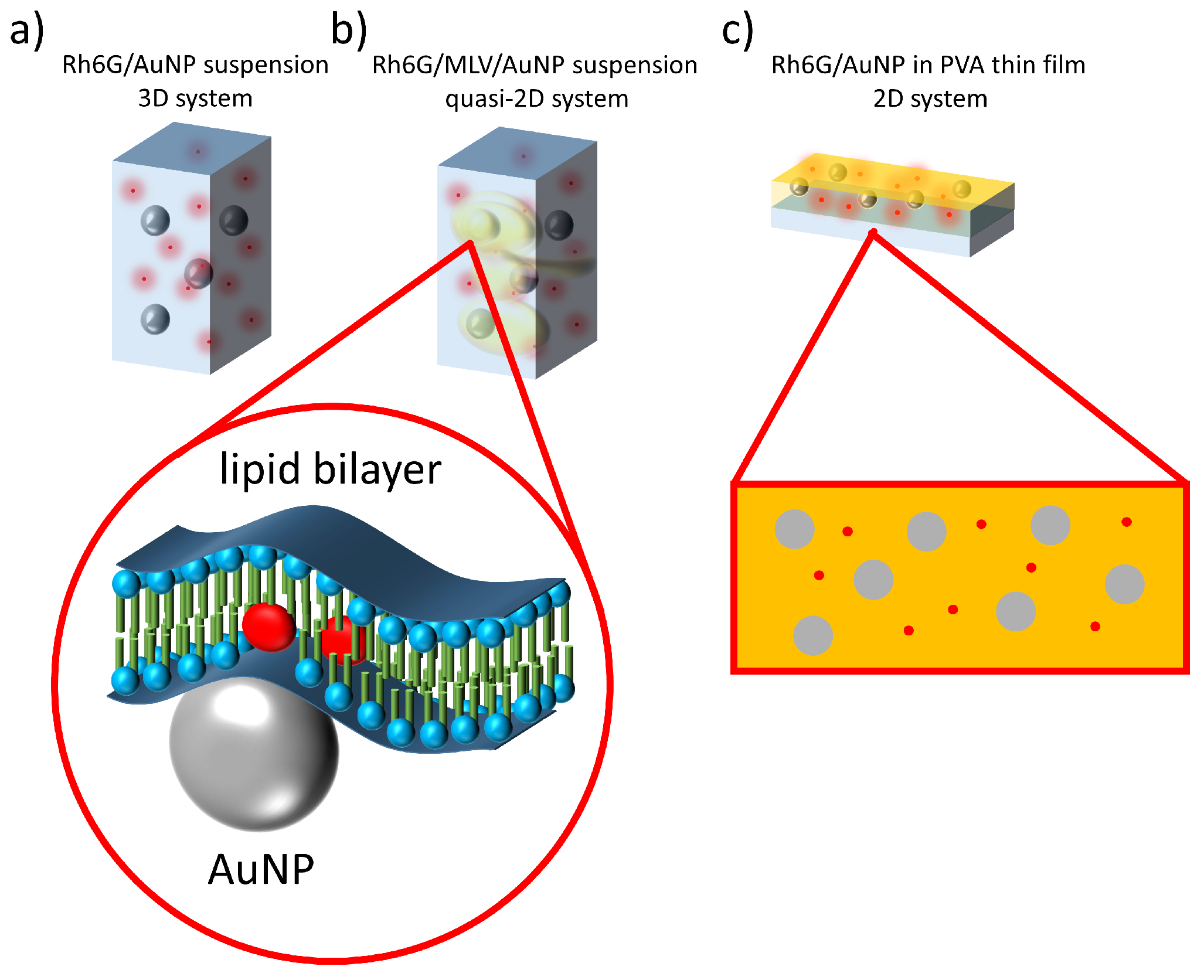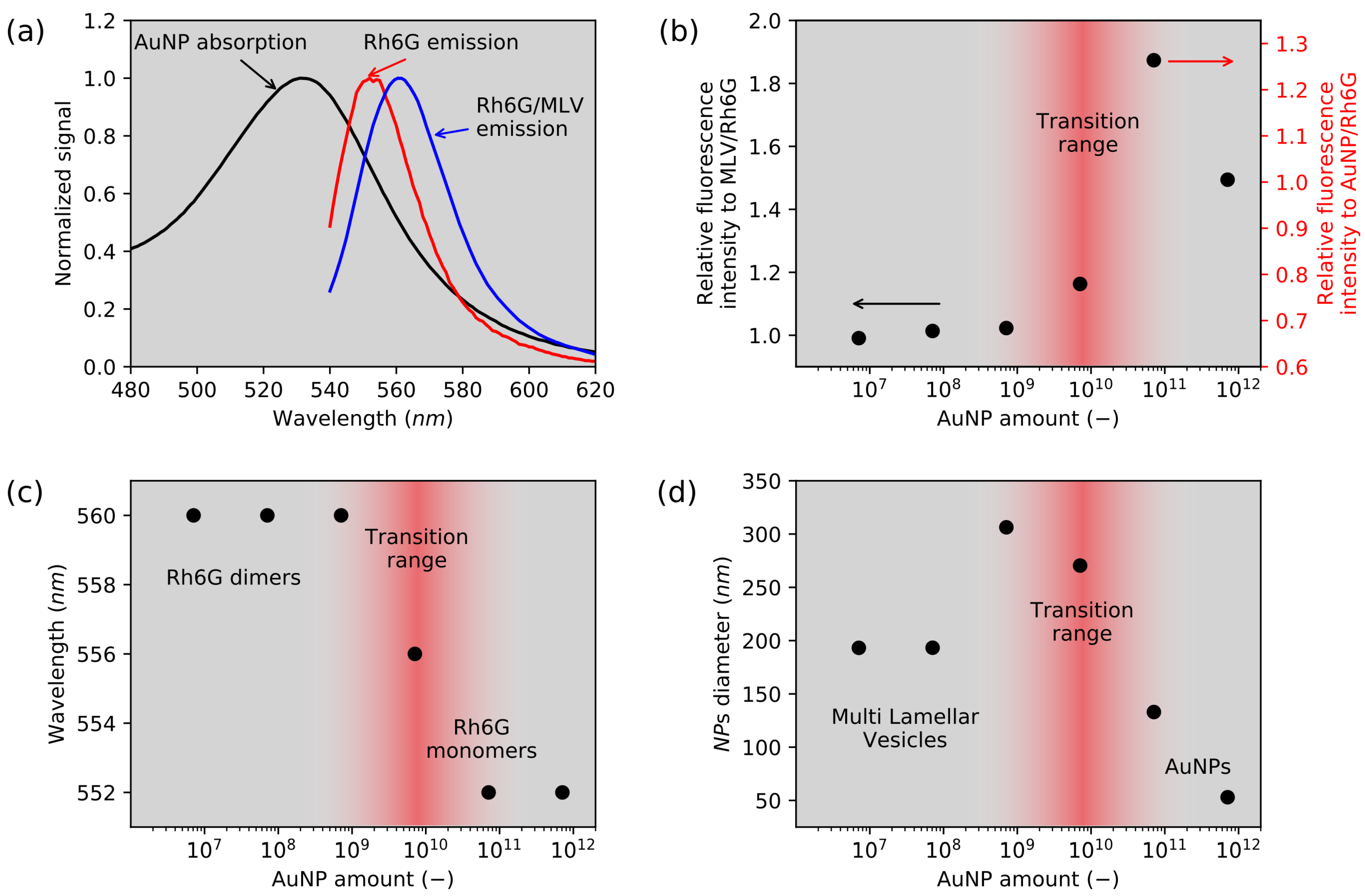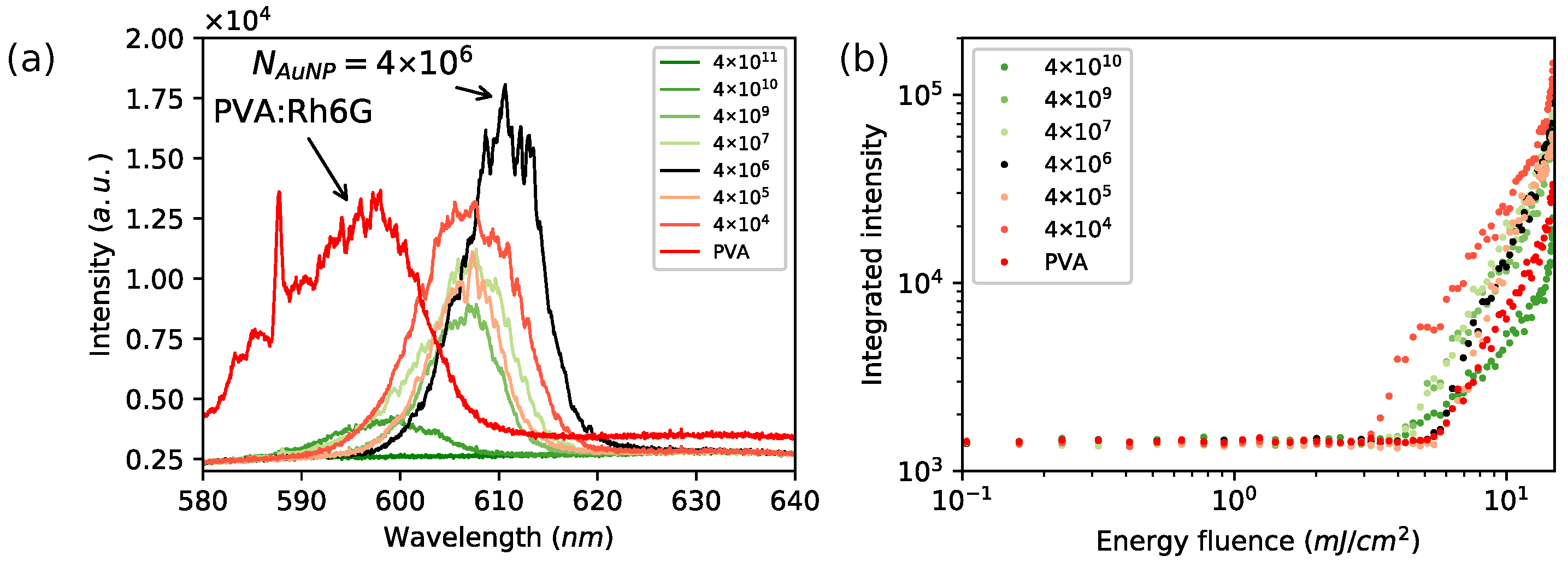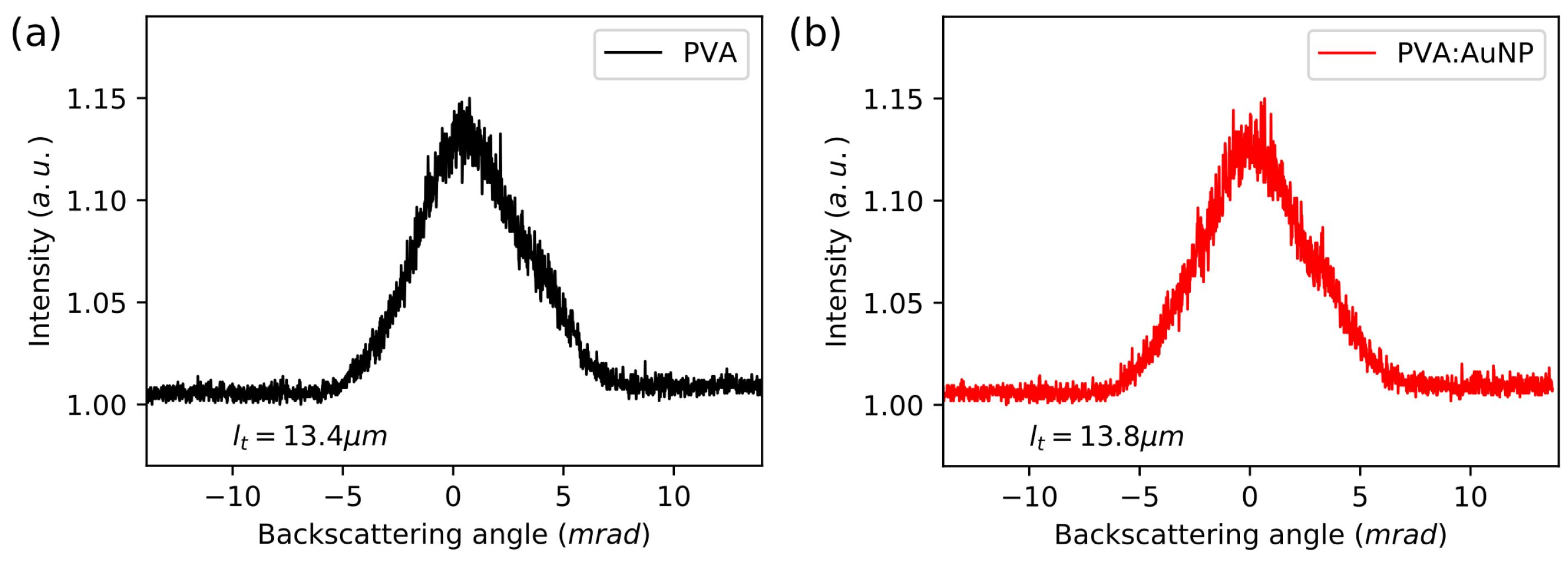Plasmonic Nanoparticles Driven Enhanced Light Amplification in a Local 2D and 3D Self-Assembly
Abstract
1. Introduction
2. Materials and Methods
2.1. Spherical Gold Nanoparticles (AuNPs) Synthesis
2.2. Dye and Nanoparticles Water Suspension—3D System
2.3. Dye/AuNPs Multilamelar Vesicles—Quasi-2D System
2.4. Dye/NPs Polymeric Thin Films—2D System
2.5. Optical Experiments
3. Results and Discussion
3.1. Water Suspensions: 3D and Quasi 2D Systems
3.2. Lasing Enhancement in PVA: 2D System
4. Conclusions
Author Contributions
Funding
Conflicts of Interest
References
- Jiang, Z.; Dong, B.; Chen, B.; Wang, J.; Xu, L.; Zhang, S.; Song, H. Multifunctional Au@ mSiO2/rhodamine B isothiocyanate nanocomposites: cell imaging, photocontrolled drug release, and photothermal therapy for cancer cells. Small 2013, 9, 604–612. [Google Scholar] [CrossRef] [PubMed]
- Huang, P.; Lin, J.; Wang, S.; Zhou, Z.; Li, Z.; Wang, Z.; Zhang, C.; Yue, X.; Niu, G.; Yang, M.; et al. Photosensitizer-conjugated silica-coated gold nanoclusters for fluorescence imaging-guided photodynamic therapy. Biomaterials 2013, 34, 4643–4654. [Google Scholar] [CrossRef] [PubMed]
- Pang, Y.; Rong, Z.; Wang, J.; Xiao, R.; Wang, S. A fluorescent aptasensor for H5N1 influenza virus detection based-on the core–shell nanoparticles metal-enhanced fluorescence (MEF). Biosens. Bioelectron. 2015, 66, 527–532. [Google Scholar] [CrossRef] [PubMed]
- Abadeer, N.S.; Brennan, M.R.; Wilson, W.L.; Murphy, C.J. Distance and plasmon wavelength dependent fluorescence of molecules bound to silica-coated gold nanorods. ACS Nano 2014, 8, 8392–8406. [Google Scholar] [CrossRef] [PubMed]
- Terentyuk, G.; Panfilova, E.; Khanadeev, V.; Chumakov, D.; Genina, E.; Bashkatov, A.; Tuchin, V.; Bucharskaya, A.; Maslyakova, G.; Khlebtsov, N.; et al. Gold nanorods with a hematoporphyrin-loaded silica shell for dual-modality photodynamic and photothermal treatment of tumors in vivo. Nano Res. 2014, 7, 325–337. [Google Scholar] [CrossRef]
- Croissant, J.; Maynadier, M.; Mongin, O.; Hugues, V.; Blanchard-Desce, M.; Chaix, A.; Cattoën, X.; Wong Chi Man, M.; Gallud, A.; Gary-Bobo, M.; et al. Enhanced two-photon fluorescence imaging and therapy of cancer cells via gold@ bridged silsesquioxane nanoparticles. Small 2015, 11, 295–299. [Google Scholar] [CrossRef] [PubMed]
- Ishifuji, M.; Mitsuishi, M.; Miyashita, T. Bottom-up design of hybrid polymer nanoassemblies elucidates plasmon-enhanced second harmonic generation from nonlinear optical dyes. JACS 2009, 131, 4418–4424. [Google Scholar] [CrossRef]
- Naor, H.; Avnir, D. Electroless methods for molecular doping of gold thin films. J. Mater. Chem. C 2014, 2, 7768–7775. [Google Scholar] [CrossRef]
- Schneider, G.; Decher, G.; Nerambourg, N.; Praho, R.; Werts, M.H.; Blanchard-Desce, M. Distance-dependent fluorescence quenching on gold nanoparticles ensheathed with layer-by-layer assembled polyelectrolytes. Nano Lett. 2006, 6, 530–536. [Google Scholar] [CrossRef]
- Ni, W.; Yang, Z.; Chen, H.; Li, L.; Wang, J. Coupling between molecular and plasmonic resonances in freestanding dye- gold nanorod hybrid nanostructures. J. Am. Chem. Soc. 2008, 130, 6692–6693. [Google Scholar] [CrossRef]
- Navarro, J.R.; Liotta, A.; Faure, A.C.; Lerouge, F.; Chaput, F.; Micouin, G.; Baldeck, P.L.; Parola, S. Tuning dye-to-particle interactions toward luminescent gold nanostars. Langmuir 2013, 29, 10915–10921. [Google Scholar] [CrossRef]
- Sivapalan, S.T.; Vella, J.H.; Yang, T.K.; Dalton, M.J.; Swiger, R.N.; Haley, J.E.; Cooper, T.M.; Urbas, A.M.; Tan, L.S.; Murphy, C.J. Plasmonic enhancement of the two photon absorption cross section of an organic chromophore using polyelectrolyte-coated gold nanorods. Langmuir 2012, 28, 9147–9154. [Google Scholar] [CrossRef]
- Navarro, J.R.; Lerouge, F.; Cepraga, C.; Micouin, G.; Favier, A.; Chateau, D.; Charreyre, M.T.; Lanoë, P.H.; Monnereau, C.; Chaput, F.; et al. Nanocarriers with ultrahigh chromophore loading for fluorescence bio-imaging and photodynamic therapy. Biomaterials 2013, 34, 8344–8351. [Google Scholar] [CrossRef]
- Stuchinskaya, T.; Moreno, M.; Cook, M.J.; Edwards, D.R.; Russell, D.A. Targeted photodynamic therapy of breast cancer cells using antibody–phthalocyanine–gold nanoparticle conjugates. Photochem. Photobiol. Sci. 2011, 10, 822–831. [Google Scholar] [CrossRef] [PubMed]
- Hone, D.C.; Walker, P.I.; Evans-Gowing, R.; FitzGerald, S.; Beeby, A.; Chambrier, I.; Cook, M.J.; Russell, D.A. Generation of cytotoxic singlet oxygen via phthalocyanine-stabilized gold nanoparticles: A potential delivery vehicle for photodynamic therapy. Langmuir 2002, 18, 2985–2987. [Google Scholar] [CrossRef]
- Xu, Y.K.; Hwang, S.; Kim, S.; Chen, J.Y. Two orders of magnitude fluorescence enhancement of aluminum phthalocyanines by gold nanocubes: A remarkable improvement for cancer cell imaging and detection. ACS Appl. Mater. Interfaces 2014, 6, 5619–5628. [Google Scholar] [CrossRef] [PubMed]
- Zaiba, S.; Lerouge, F.; Gabudean, A.M.; Focsan, M.; Lermé, J.; Gallavardin, T.; Maury, O.; Andraud, C.; Parola, S.; Baldeck, P.L. Transparent plasmonic nanocontainers protect organic fluorophores against photobleaching. Nano Lett. 2011, 11, 2043–2047. [Google Scholar] [CrossRef]
- Parola, S.; Julián-López, B.; Carlos, L.D.; Sanchez, C. Optical Properties of Hybrid Organic-Inorganic Materials and their Applications. Adv. Funct. Mater. 2016, 26, 6506–6544. [Google Scholar] [CrossRef]
- Horimoto, N.N.; Imura, K.; Okamoto, H. Dye fluorescence enhancement and quenching by gold nanoparticles: Direct near-field microscopic observation of shape dependence. Chem. Phys. Lett. 2008, 467, 105–109. [Google Scholar] [CrossRef]
- Jain, S.; Hirst, D.; O’sullivan, J. Gold nanoparticles as novel agents for cancer therapy. Br. J. Radiol. 2012, 85, 101–113. [Google Scholar] [CrossRef] [PubMed]
- Qin, Z.; Bischof, J.C. Thermophysical and biological responses of gold nanoparticle laser heating. Chem. Soc. Rev. 2012, 41, 1191–1217. [Google Scholar] [CrossRef] [PubMed]
- Letfullin, R.R.; Joenathan, C.; George, T.F.; Zharov, V.P. Laser-induced explosion of gold nanoparticles: Potential role for nanophotothermolysis of cancer. Future Med. 2006, 4, 473–480. [Google Scholar] [CrossRef] [PubMed]
- Mitsuishi, M.; Ishifuji, M.; Endo, H.; Tanaka, H.; Miyashita, T. Hybrid polymer nanoassemblies: Polymer nanosheets organized with metal nanoparticle arrays for surface plasmon photonics. Polym. J. 2007, 39, 411. [Google Scholar] [CrossRef]
- El-Bashir, S.; Barakat, F.; AlSalhi, M. Metal-enhanced fluorescence of mixed coumarin dyes by silver and gold nanoparticles: Towards plasmonic thin-film luminescent solar concentrator. J. Lumin. 2013, 143, 43–49. [Google Scholar] [CrossRef]
- Chen, J.; Jin, Y.; Fahruddin, N.; Zhao, J.X. Development of gold nanoparticle-enhanced fluorescent nanocomposites. Langmuir 2013, 29, 1584–1591. [Google Scholar] [CrossRef] [PubMed]
- Lundén, H.; Liotta, A.; Chateau, D.; Lerouge, F.; Chaput, F.; Parola, S.; Brännlund, C.; Ghadyani, Z.; Kildemo, M.; Lindgren, M.; et al. Dispersion and self-orientation of gold nanoparticles in sol–gel hybrid silica–optical transmission properties. J. Mater. Chem. C 2015, 3, 1026–1034. [Google Scholar] [CrossRef]
- Chateau, D.; Liotta, A.; Lundén, H.; Lerouge, F.; Chaput, F.; Krein, D.; Cooper, T.; Lopes, C.; El-Amay, A.A.; Lindgren, M.; et al. Long Distance Enhancement of Nonlinear Optical Properties Using Low Concentration of Plasmonic Nanostructures in Dye Doped Monolithic Sol–Gel Materials. Adv. Funct. Mater. 2016, 26, 6005–6014. [Google Scholar] [CrossRef]
- Chateau, D.; Liotta, A.; Gregori, D.; Lerouge, F.; Chaput, F.; Desert, A.; Parola, S. Controlled surface modification of gold nanostructures with functionalized silicon polymers. J. Sol-Gel Sci. Technol. 2017, 81, 147–153. [Google Scholar] [CrossRef]
- Kim, S.; Ohulchanskyy, T.Y.; Pudavar, H.E.; Pandey, R.K.; Prasad, P.N. Organically modified silica nanoparticles co-encapsulating photosensitizing drug and aggregation-enhanced two-photon absorbing fluorescent dye aggregates for two-photon photodynamic therapy. J. Am. Chem. Soc. 2007, 129, 2669–2675. [Google Scholar] [CrossRef] [PubMed]
- Xia, B.; He, F.; Li, L. Metal-enhanced fluorescence using aggregated silver nanoparticles. Colloids Surf. A 2014, 444, 9–14. [Google Scholar] [CrossRef]
- Popov, O.; Zilbershtein, A.; Davidov, D. Random lasing from dye-gold nanoparticles in polymer films: Enhanced gain at the surface-plasmon-resonance wavelength. Appl. Phys. Lett. 2006, 89, 191116. [Google Scholar] [CrossRef]
- Luan, F.; Gu, B.; Gomes, A.S.; Yong, K.T.; Wen, S.; Prasad, P.N. Lasing in nanocomposite random media. Nano Today 2015, 10, 168–192. [Google Scholar] [CrossRef]
- Mysliwiec, J.; Cyprych, K.; Sznitko, L.; Miniewicz, A. Biomaterials in light amplification. J. Opt. 2017, 19, 033003. [Google Scholar] [CrossRef]
- Ziegler, J.; Worister, C.; Vidal, C.; Hrelescu, C.; Klar, T.A. Plasmonic nanostars as efficient broadband scatterers for random lasing. ACS Photonics 2016, 3, 919–923. [Google Scholar] [CrossRef] [PubMed]
- Wang, C.; Chen, Y.; Lin, H.; Chen, Y.; Chen, Y. Enhancement of random lasing through fluorescence resonance energy transfer and light scattering mediated by nanoparticles. Appl. Phys. Lett. 2010, 97, 191104. [Google Scholar] [CrossRef]
- Dos Santos, M.V.; Dominguez, C.T.; Schiavon, J.V.; Barud, H.S.; de Melo, L.S.; Ribeiro, S.J.; Gomes, A.S.; de Araújo, C.B. Random laser action from flexible biocellulose-based device. J. Appl. Phys. 2014, 115, 083108. [Google Scholar] [CrossRef]
- Stepniewski, M.; Pasenkiewicz-Gierula, M.; Róg, T.; Danne, R.; Orlowski, A.; Karttunen, M.; Urtti, A.; Yliperttula, M.; Vuorimaa, E.; Bunker, A. Study of PEGylated lipid layers as a model for PEGylated liposome surfaces: Molecular dynamics simulation and Langmuir monolayer studies. Langmuir 2011, 27, 7788–7798. [Google Scholar] [CrossRef]
- Liu, X.; Atwater, M.; Wang, J.; Huo, Q. Extinction coefficient of gold nanoparticles with different sizes and different capping ligands. Colloids Surf. B 2007, 58, 3–7. [Google Scholar] [CrossRef]
- Hope, M.; Bally, M.; Mayer, L.; Janoff, A.; Cullis, P. Generation of multilamellar and unilamellar phospholipid vesicles. Chem. Phys. Lipids 1986, 40, 89–107. [Google Scholar] [CrossRef]
- Mayer, L.; Hope, M.; Cullis, P. Vesicles of variable sizes produced by a rapid extrusion procedure. Biochim. Biophys. Acta 1986, 858, 161–168. [Google Scholar] [CrossRef]
- Mozafari, M.R. Liposomes: An overview of manufacturing techniques. Cell. Mol. Biol. Lett. 2005, 10, 711. [Google Scholar]
- Corey, R.; Kissner, M.; Saulnier, P. Coherent backscattering of light. Am. J. Phys. 1995, 63, 560–564. [Google Scholar] [CrossRef]
- Van Der Mark, M.B.; van Albada, M.P.; Lagendijk, A. Light scattering in strongly scattering media: Multiple scattering and weak localization. Phys. Rev. B 1988, 37, 3575. [Google Scholar] [CrossRef]
- Martínez Martínez, V.; López Arbeloa, F.; Bañuelos Prieto, J.; Arbeloa López, T.; López Arbeloa, I. Characterization of rhodamine 6G aggregates intercalated in solid thin films of laponite clay. 1. Absorption spectroscopy. J. Phys. Chem. B 2004, 108, 20030–20037. [Google Scholar] [CrossRef]
- Martínez Martínez, V.; López Arbeloa, F.; Bañuelos Prieto, J.; López Arbeloa, I. Characterization of rhodamine 6G aggregates intercalated in solid thin films of laponite clay. 2 Fluorescence spectroscopy. J. Phys. Chem. B 2005, 109, 7443–7450. [Google Scholar] [CrossRef] [PubMed]
- Cyprych, K.; Kopczyńska, Z.; Kajzar, F.; Rau, I.; Mysliwiec, J. Tunable wavelength light emission and amplification in Rhodamine 6G aggregates. Adv. Device Mater. 2015, 1, 69–73. [Google Scholar] [CrossRef]
- Wang, J.H.; Bartlett, J.; Dunn, A.; Small, S.; Willis, S.; Driver, M.; Lewis, A. The use of rhodamine 6G and fluorescence microscopy in the evaluation of phospholipid-based polymeric biomaterials. J. Microsc. 2005, 217, 216–224. [Google Scholar] [CrossRef]
- Cyprych, K.; Sznitko, L.; Mysliwiec, J. Starch: Application of biopolymer in random lasing. Org. Electron. 2014, 15, 2218–2222. [Google Scholar] [CrossRef]
- Cyprych, K.; Janeczko, M.; Rau, I.; Kajzar, F.; Mysliwiec, J. Collagen network as the scaffold for spontaneously distributed optical resonators. Org. Electron. 2016, 39, 100–104. [Google Scholar] [CrossRef]
- Penzkofer, A.; Lu, Y. Fluorescence quenching of rhodamine 6G in methanol at high concentration. Chem. Phys. 1986, 103, 399–405. [Google Scholar] [CrossRef]





| Sample | AuNP Amount | Lasing Threshold | Relative Intensity |
|---|---|---|---|
| N | th [mJ/cm] | ||
| reference | 0.0 | 5.7 | 1.00 |
| 1 | no emission | 0.00 | |
| 2 | 4.3 | 0.01 | |
| 3 | 4.0 | 0.53 | |
| 4 | 4.2 | 0.78 | |
| 5 | 5.6 | 1.54 | |
| 6 | 5.4 | 0.77 | |
| 7 | 2.9 | 0.96 |
© 2018 by the authors. Licensee MDPI, Basel, Switzerland. This article is an open access article distributed under the terms and conditions of the Creative Commons Attribution (CC BY) license (http://creativecommons.org/licenses/by/4.0/).
Share and Cite
Cyprych, K.; Chateau, D.; Désert, A.; Parola, S.; Mysliwiec, J. Plasmonic Nanoparticles Driven Enhanced Light Amplification in a Local 2D and 3D Self-Assembly. Nanomaterials 2018, 8, 1051. https://doi.org/10.3390/nano8121051
Cyprych K, Chateau D, Désert A, Parola S, Mysliwiec J. Plasmonic Nanoparticles Driven Enhanced Light Amplification in a Local 2D and 3D Self-Assembly. Nanomaterials. 2018; 8(12):1051. https://doi.org/10.3390/nano8121051
Chicago/Turabian StyleCyprych, Konrad, Denis Chateau, Anthony Désert, Stephane Parola, and Jaroslaw Mysliwiec. 2018. "Plasmonic Nanoparticles Driven Enhanced Light Amplification in a Local 2D and 3D Self-Assembly" Nanomaterials 8, no. 12: 1051. https://doi.org/10.3390/nano8121051
APA StyleCyprych, K., Chateau, D., Désert, A., Parola, S., & Mysliwiec, J. (2018). Plasmonic Nanoparticles Driven Enhanced Light Amplification in a Local 2D and 3D Self-Assembly. Nanomaterials, 8(12), 1051. https://doi.org/10.3390/nano8121051







